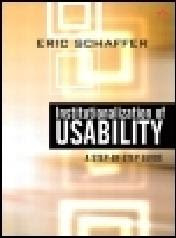 |
By Eric Schaffer
Publisher : Addison Wesley
Pub Date : February 13, 2004
ISBN : 0-321-17934-X
Pages : 304
Slots : 1.0
At one time, computer hardware was the key differentiator in information technology—what gave an organization it's competitive edge. Then, as hardware prices fell, software took center stage. Today, software having become a broadly shared commodity, a new differentiator has emerged—usability. Applications, including Web sites, are usable if they are practical, useful, easy to work with, and satisfying. Usability is now the factor likeliest to give an organization a distinct advantage.
Institutionalization of Usability shows how to make user-centered design and development a routine practice within an enterprise. Other excellent books explain precisely how to make software usable; this book builds on that foundation, and focuses instead on how to get usability recognized and incorporated into an organization's values and culture. Based on author Eric Schaffer's extensive experience, the book provides a solid methodology for institutionalizing usability, guiding readers step-by-step with practical advice on topics like organizational change, milestones, toolsets, infrastructure, and staffing requirements needed to achieve fully mature usability engineering.
Learn how to:
(1)Educate your organization about the importance of usability
(2)Hire and coordinate usability staff and consultants
(3)Plan the standards, design, and implementation phases
(4)Retrofit a method that has added user-centered activities
(5)Recruit participants for usability interviews and testing
(6)Select the right staff and project to showcase-by timeline, user impact,and visibility
(7)Evangelize, train and mentor staff, and support the community
Whether you are an executive leading the institutionalization process, a manager supporting the transition, or an engineer working on usability issues, Institutionalization of Usability will help you to build usability into your software practices.





























